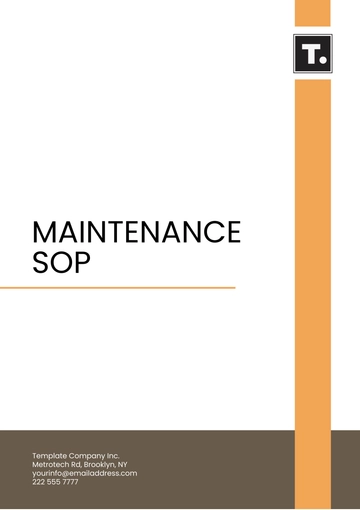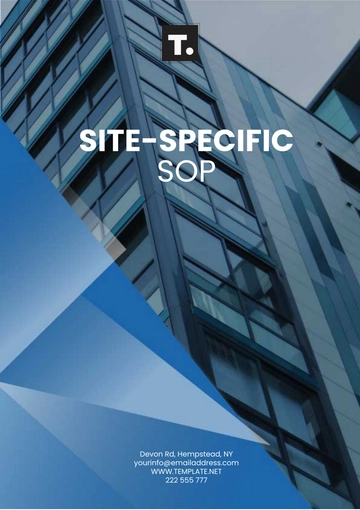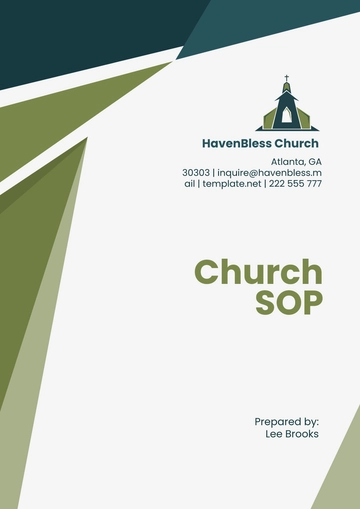Free Workplace Incident SOP

1. Introduction
This document is a critical component of our commitment to ensuring a safe, secure, and responsive working environment. Workplace incidents, ranging from minor accidents to significant emergencies, can occur unexpectedly and have far-reaching implications for employee well-being, operational continuity, and the organization's reputation. In light of this, [Your Company Name] has developed this SOP to establish a clear, structured, and effective protocol for managing such incidents.
The workplace is a dynamic environment where diverse activities converge, creating a spectrum of risk factors. These can include, but are not limited to, physical hazards, equipment malfunctions, human errors, and environmental factors. The varied nature of these risks necessitates a robust and flexible approach to incident management. This SOP serves as a comprehensive guide, encompassing the steps to be followed from the moment an incident occurs until its full resolution and post-incident review.
Our approach is proactive, focusing on rapid response, thorough investigation, and implementation of corrective actions to mitigate risks and prevent recurrence. By adhering to this SOP, [Your Company Name] aims to not only respond effectively to incidents but also foster a culture of safety and awareness among all stakeholders. This document is a testament to our commitment to upholding the highest standards of workplace safety and regulatory compliance.
Purpose:
The primary purpose of this Workplace Incident SOP is to provide a standardized, systematic approach to managing workplace incidents at [Your Company Name]. This SOP is designed to ensure that all incidents, regardless of their nature or severity, are handled promptly, effectively, and in a manner that prioritizes the safety and well-being of our employees, contractors, and visitors. The objectives of this SOP include:
Rapid Response and Effective Management: To enable immediate and effective response to any workplace incident, ensuring that the impacts are minimized, and normal operations are restored as quickly as possible.
Clear Communication and Reporting: To establish clear lines of communication and reporting protocols, ensuring that incidents are promptly reported and appropriately escalated.
Comprehensive Investigation and Analysis: To conduct thorough investigations to ascertain the root causes of incidents, thereby facilitating the development of effective strategies to prevent future occurrences.
Compliance and Best Practices: To ensure compliance with legal and regulatory requirements related to workplace safety, and to align with industry best practices in incident management.
Training and Awareness: To provide ongoing training and raise awareness among staff and stakeholders about incident management procedures and their roles in promoting a safe working environment.
SCOPE
This SOP is applicable to all employees, contractors, and visitors within the premises of [Your Company Address]. It encompasses a wide range of potential incidents, including but not limited to workplace injuries, equipment failures, environmental hazards, and security breaches. The procedures outlined in this document must be followed in the event of any such incident, regardless of its scale or perceived impact.
The scope of this SOP also extends to the preparation and prevention aspects of incident management. This includes regular training sessions, safety drills, and awareness campaigns designed to equip our workforce with the knowledge and skills necessary to respond to and prevent workplace incidents effectively.
In summary, this Workplace Incident SOP is an essential tool for safeguarding the health and safety of our workforce, maintaining operational integrity, and upholding the values and reputation of [Your Company Name]. It is a living document, subject to review and updates, ensuring it remains relevant and effective in the face of changing workplace dynamics and evolving industry standards.
2. Definitions
To ensure a clear understanding and effective implementation of this Standard Operating Procedure (SOP), it is vital to define key terms used throughout the document. These definitions provide a common language for discussing and managing workplace incidents at [Your Company Name].
Term | Definition | Key Aspects | Importance |
Workplace Incident | An unplanned or unexpected event occurring within the workplace environment or during work-related activities, potentially resulting in harm or disruption. | Injuries or Illnesses: Physical harm or medical conditions arising during work (e.g., falls, cuts, burns).<br>- Property Damage: Damage to company property, equipment, or facilities.<br>- Environmental Incidents: Events adversely affecting the environment (e.g., spills, leaks).<br>- Security Breaches: Incidents like unauthorized access, theft, or vandalism.<br>- System Failures: Malfunctions in critical systems or equipment. | Essential for effective response and prevention strategies; helps in categorizing and managing incidents. |
Incident Report | A formal document completed after a workplace incident, detailing the specifics of the event. | Record of Events: Date, time, location, and description of the incident.<br>- Involvement Details: Identification of individuals involved, witnesses, and immediate actions.<br>- Impact Assessment: Evaluation of consequences like injuries, property damage, or operational disruptions.<br>- Root Cause Analysis: Initial analysis of factors leading to the incident.<br>- Documentation for Follow-up: Key document for further investigation, actions, and compliance. | Crucial for capturing accurate information, facilitating effective communication, investigation, and continuous safety enhancement. |
3. Incident Management Procedure
The Incident Management Procedure in the Workplace Incident SOP at [Your Company Name] provides a concise, yet comprehensive framework for addressing workplace incidents. This chapter delineates a clear sequence of steps, each detailing specific actions, responsible parties, and timelines, beginning with immediate incident identification by employees or visitors, and culminating in regular follow-ups and reviews. The initial stages emphasize rapid response and reporting, crucial for mitigating immediate risks and ensuring prompt attention to the incident.
Subsequent steps involve detailed investigation by the Incident Investigation Team, development of a Corrective Action Plan by the Safety Manager, and implementation of these actions by relevant departments. This systematic approach ensures thorough handling of each incident, from initial assessment to resolution and review. The procedure underscores [Your Company Name]'s commitment to a safe working environment, prioritizing efficient management and prevention of workplace incidents.
Step | Action Item | Responsible Party | Timeline |
1 | Incident Identification | Employee/Visitor | Immediate |
2 | Incident Reporting | Employee/Visitor | Within 24 hours |
3 | Initial Assessment | Safety Officer | Within 2 hours of report |
4 | Notification to Management | Safety Officer | As soon as assessment is complete |
5 | Detailed Investigation | Incident Investigation Team | Within 48 hours |
6 | Corrective Action Plan | Safety Manager | Within 5 working days |
7 | Implementation of Actions | Relevant Department(s) | As per the action plan |
8 | Follow-Up and Review | Safety Committee | Every 30 days for 3 months |
4. Reporting Protocols
This section is pivotal in ensuring that all incidents, regardless of their size or impact, are reported in a timely and systematic manner. Prompt and accurate reporting is the cornerstone of effective incident management, laying the groundwork for swift action and resolution. The protocols outlined here are designed to facilitate this process, ensuring that every incident is documented and addressed appropriately.
1. Immediate Reporting
The first line of response in the event of an incident is its immediate reporting. Employees or visitors who witness or are involved in an incident are required to promptly inform their nearest supervisor or the Safety Officer. This step is crucial for initiating a rapid response, particularly in situations that may pose immediate risks to health and safety. Immediate reporting allows for quick assessment and deployment of necessary measures to contain and manage the incident, minimizing potential harm and disruption.
2. Written Report
Following the initial verbal report, a formal written incident report must be submitted. This is to be done via [Your Company Email] or through the incident reporting system available on [Your Company Website]. The written report serves as an official record of the incident, providing detailed information including the nature of the incident, those involved, and any immediate measures taken. This comprehensive documentation is essential for subsequent investigations and for developing strategies to prevent future occurrences. It ensures that every aspect of the incident is recorded and available for review, thereby supporting a thorough and systematic approach to incident management.
5. Incident Investigation
Incident Investigation plays a crucial role in understanding and mitigating workplace incidents. This section delves into the systematic process of investigating incidents, aiming to uncover their root causes and prevent future occurrences. The investigation is not just a reactive measure; it is a proactive step towards enhancing overall workplace safety and fostering a culture of continuous improvement.
1. Objective
The primary objective of the Incident Investigation process is to thoroughly analyze the events leading up to and surrounding the incident. This investigation seeks to identify the root causes - factors that fundamentally contributed to the occurrence of the incident. By understanding these underlying causes, [Your Company Name] can develop targeted measures and strategies to prevent similar incidents in the future. This objective-driven approach ensures that the investigation goes beyond superficial factors, providing valuable insights for long-term safety enhancements.
2. Team
To conduct a comprehensive and unbiased investigation, an Incident Investigation Team is constituted, comprising members from relevant departments. This multidisciplinary team brings together a range of perspectives and expertise, essential for a holistic examination of the incident. Team members may include safety professionals, departmental representatives, technical experts, and others whose input can provide depth to the investigation. The diversity of the team ensures a thorough and inclusive approach, considering all possible factors and influences that might have played a role in the incident. This collaborative effort underscores the commitment of [Your Company Name] to addressing workplace safety in a comprehensive and inclusive manner.
6. Corrective Actions and Follow-Up
Corrective Actions and Follow-Up are a critical segment that addresses how the organization responds and adapts following an incident. This section focuses on the steps necessary to not only address the immediate consequences of an incident but also to implement long-term strategies to prevent recurrence. The aim is to turn every incident into a learning opportunity, enhancing the safety protocols and practices within the company.
1. Development
After an incident, the Safety Manager plays a pivotal role in developing a Corrective Action Plan. This plan is a comprehensive outline of the measures required to prevent similar incidents in the future. It is formulated based on the findings of the Incident Investigation and involves identifying and rectifying root causes, enhancing safety protocols, and improving training and awareness. The development of this plan is a meticulous process, ensuring that all aspects of the incident are considered and addressed effectively.
2. Implementation
The responsibility of putting the Corrective Action Plan into action lies with the relevant departments. This phase is crucial as it translates the theoretical aspects of the plan into practical steps and procedures within the workplace. The departments are tasked with executing the prescribed measures, which may include physical changes to the workspace, modifications in operational procedures, or employee training programs. This stage is critical for actualizing the improvements and enhancements proposed in the plan.
3. Monitoring
To ensure the effectiveness of the corrective actions, continuous monitoring by the Safety Committee is essential. This committee oversees the implementation of the action plan and evaluates its efficacy in preventing similar incidents. Regular monitoring and review allow for adjustments and improvements to the plan, ensuring that the actions taken are not only effective but also sustainable. This ongoing assessment reflects [Your Company Name]'s commitment to continuous improvement in workplace safety and incident management.
Overall, this chapter underscores the organization's dedication to not only responding to incidents but more importantly, learning from them and adapting its practices for a safer and more secure working environment.
7. Training and Awareness
Training and Awareness are vital components of the Workplace Incident SOP at [Your Company Name], emphasizing the role of education and consciousness in promoting workplace safety. This section highlights the organization's commitment to not just reactively managing incidents, but proactively preventing them through continuous learning and awareness-building. It underscores the belief that a well-informed and well-trained workforce is fundamental to maintaining a safe working environment.
1. Regular Training
Central to this approach is the provision of regular training for all employees. These training sessions are designed to educate staff on the procedures for reporting incidents and the steps to take in response to various workplace emergencies. The goal is to equip every employee, regardless of their role or level, with the knowledge and skills necessary to act swiftly and appropriately in the face of potential dangers. By doing so, [Your Company Name] ensures that every member of the organization is prepared to contribute to the safety and well-being of the workplace.
2. Awareness Campaigns
Complementing regular training, [Your Company Name] also conducts ongoing awareness campaigns. These campaigns are aimed at reinforcing the importance of workplace safety, keeping it at the forefront of employees' minds. Through various mediums such as posters, newsletters, workshops, and meetings, these campaigns serve to continually remind staff of safety protocols, encourage vigilance, and promote a culture of safety. By regularly engaging with employees on this topic, the company fosters an environment where safety is a shared responsibility and a fundamental aspect of the work culture.
9. Record Keeping and Documentation
Record Keeping and Documentation are essential elements of the Workplace Incident SOP at [Your Company Name], focusing on the systematic preservation and management of incident-related information. This section outlines the company’s approach to maintaining accurate and secure records of all incidents and the subsequent actions taken. The emphasis is on creating a reliable repository of data that can be referenced for future safety measures, legal compliance, and continuous improvement in incident management.
1. Incident Reports
A key aspect of this process is the secure storage of all incident reports. Every report generated following a workplace incident is carefully archived in the company’s database. This practice ensures that detailed accounts of each incident, including descriptions, involved parties, and immediate actions taken, are preserved and accessible for future reference. Secure storage not only protects sensitive information but also allows for easy retrieval and analysis, facilitating a thorough understanding of incident trends and patterns over time.
2. Review Records
In addition to incident reports, records of incident reviews and corrective actions are meticulously maintained. These records include details of investigations, findings, corrective measures proposed and implemented, and the outcomes of these actions. This documentation is preserved for a specified duration, in compliance with legal requirements and organizational policies. The longevity of these records enables ongoing evaluation of the effectiveness of corrective actions, providing a basis for revising and refining safety procedures and practices.
9. Amendment and Review of SOP
Recognizing that workplace environments, legal requirements, and best practices are continually evolving, this SOP is subject to an annual review, or more frequently if necessitated by changes in legislation or company policy. This regular review process involves evaluating the SOP’s current protocols and procedures in the light of new developments, operational feedback, and emerging risks. The aim is to ensure that the SOP remains aligned with the latest safety standards and regulatory requirements, and effectively addresses the dynamic needs of the workplace. Amendments, if required, are made with careful consideration, involving consultation with relevant stakeholders and experts to maintain the SOP’s integrity and applicability in promoting a safe and compliant work environment.
10. Contact Information
Department | Contact | Phone Number | |
Safety | [Safety Officer Name] | [Your Company Email] | [Your Company Phone Number] |
11. Acknowledgement
I, [Your Name], acknowledge that I have read and understood the Workplace Incident SOP of [Your Company Name] and agree to comply with the procedures and responsibilities outlined within.
Signature: ______________________
Date: [Month Day Year]
- 100% Customizable, free editor
- Access 1 Million+ Templates, photo’s & graphics
- Download or share as a template
- Click and replace photos, graphics, text, backgrounds
- Resize, crop, AI write & more
- Access advanced editor
Enhance workplace safety with Template.net's Workplace Incident SOP Template. This editable and customizable document, accessible through our Ai Editor Tool, streamlines Standard Operating Procedures for incident management. Empower your team to respond effectively to emergencies, ensuring a secure work environment. Safeguard your operations with Template.net's innovative solutions.





























